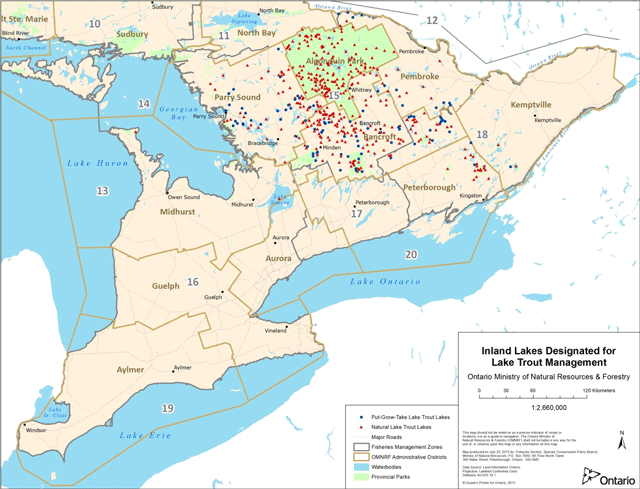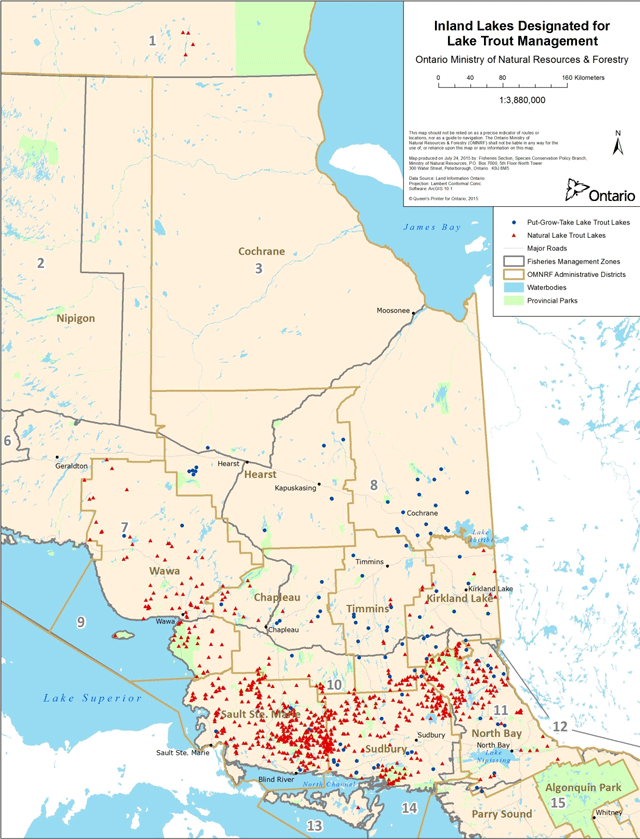Inland lakes designated for lake trout management
Learn about Ontario lakes (excluding the Great Lakes) that are being managed for naturally reproducing lake trout and for the "put-grow-take" fish stocking program.
ISBN 978-1-4606-6257-1 (PDF)
Fisheries Section
Species Conservation Policy Branch
Ontario Ministry of Natural Resources
P.O. Box 7000, 300 Water Street
Peterborough, ON K9J 8M5
A prerequisite to the effective management of a resource is a knowledge of the distribution and magnitude of that resource.”
Introductory sentence from “The Distribution and Characteristics of Ontario Lake Trout Lakes” (Martin and Olver 1976).
Abstract
Lake Trout lakes are rare. Only about one percent of Ontario’s lakes contain Lake Trout, but this represents 20-25% of all Lake Trout lakes in the world. The province, therefore, has a great responsibility to manage them wisely. Ministry efforts to develop a coordinated strategy to protect Lake Trout populations in Ontario requires a comprehensive list of lakes currently designated for Lake Trout management.
This report lists the inland Ontario lakes (exclusive of the Great Lakes) that are currently designated for Lake Trout management. In addition, the list classifies the lakes as to whether they are to be managed for naturally reproducing populations (‘Natural’ lakes) or as put-grow-take (‘P-G-T’) lakes. ‘Natural’ lakes include those lakes that may have lost populations but have been identified for rehabilitation. ‘P-G-T’ lakes are managed to provide recreational fishing opportunities and/or to direct angling effort away from more sensitive ‘Natural’ lakes. Ministry policies or guidelines may be applied differently depending on the lake classification, or in other cases may be applied to both classifications in a similar manner.
Individual Lake Trout lakes are listed alphabetically in tables organized by the ministry Administrative Regions.
Most lakes managed for Lake Trout will have been identified previously in other resource management plans. This list supersedes previously published lists and will be subject to revision from time to time, as updated scientific assessment and inventory data become available. Subsequent revisions will be posted on the EBR Registry for public notice and comment. More detailed information on individual lakes may be available from local ministry offices.
Introduction
The Lake Trout is the only major, indigenous sport fish species in Ontario that is adapted to oligotrophic lakes (i.e. lakes with low levels of nutrients, high dissolved oxygen levels, and typically deep areas with very cold water). Its slow growth, late maturity, low reproductive potential and slow replacement rate make it susceptible to a variety of stresses. It is an important component of Ontario’s rich biodiversity, because of the unique character of the species and the unique gene pools of many of its individual stocks. Because the Lake Trout is a sensitive species that is adapted to a narrow range of environmental conditions, it is an excellent indicator of the health of fragile aquatic ecosystems.
Lake Trout lakes are rare. Only about one percent of Ontario’s lakes (i.e. ~ 2,300) contain Lake Trout, but this represents 20-25% of all Lake Trout lakes in the world. The Lake Trout is an important fishery resource in Ontario. It is a preferred species among many anglers, both resident and non-resident, and provides a diversity of fishing opportunities. The province, therefore, has a great responsibility to manage them wisely.
There has been a general decline in both the quality of the sport fishery for Lake Trout and in Lake Trout habitat in many lakes. Lake Trout lakes are particularly vulnerable to the impacts of human activities, including exploitation, enrichment from cottage septic systems, acidification, species introductions, and habitat destruction. Because of their high sensitivity to disturbance, special protection is required for these lakes and their Lake Trout populations. Approximately 5% of the province’s Lake Trout populations have already become extinct; 43% of the extinct populations were in southeastern Ontario (Martin and Olver 1976; OMNR 1990).
Lake Trout Lakes in Ontario
Martin and Olver (1976) documented the (at the time) known distribution and characteristics of 2000 inland Lake Trout lakes (exclusive of the Great Lakes) in Ontario. This total included 1709 native populations, 195 introduced populations, 96 populations of unknown origin and 74 extinct populations. They recognized that additional populations would likely be found (especially in northwestern Ontario) as additional surveys were conducted.
During the Lake Trout Community Synthesis exercise, Martin and Olver’s (1976) survey of Lake Trout lakes was updated and included an evaluation of the likely status of each Lake Trout population provided by local resource managers (OMNR 1990). The updated list totaled 2318 Lake Trout lakes, of which 1827 were identified as native populations, 222 introduced populations, 83 populations of unknown origin, 122 extinct or lost populations, and 64 lakes with a population status of ‘other’ (OMNR 1990).
Gunn et al. (2004) used 1998 resource management agency data (from Ontario, Quebec, Minnesota, and New York) to update locations, surface area, maximum and mean depths, conductivity and secchi depth of Lake Trout lakes across the Boreal Shield. They provided data for 2255 Ontario Lake Trout lakes (excluding lakes > 10,000 ha) and acknowledged that at the time of publication they lacked locational data for approximately 100 additional Ontario Lake Trout lakes.
While these previous efforts have been valuable in characterizing Ontario’s Lake Trout resource, the resulting lists include lakes which may have supported Lake Trout populations at one time, but are no longer being actively managed for Lake Trout. A coordinated strategy to protect Lake Trout populations in Ontario requires a comprehensive list of Lake Trout lakes currently designated for Lake Trout management.
Lakes designated for Lake Trout management
This report lists the inland Ontario lakes (exclusive of the Great Lakes) that are currently designated for Lake Trout management. In addition this list classifies the lakes as to whether they are to be managed for naturally reproducing populations (‘Natural’ lakes) or as put-grow-take lakes (‘P-G-T’ lakes). ‘Natural’ lakes include those lakes that may have lost populations but have been identified for rehabilitation. For example, restoration efforts of acid damaged lakes in the Sudbury area have improved water chemistry and allowed for the reintroduction of Lake Trout in order to re-establish viable populations. ‘P-G-T’ lakes are stocked and managed to provide recreational fishing opportunities and/or to direct angling effort away from more sensitive ‘Natural’ lakes.
Ministry policies or guidelines may be applied differently to designated Lake Trout lakes depending on the lake classification (e.g. sport fishing regulations are generally less restrictive on P-G-T lakes; adjacent land management or land use policies may differ according to designation). In other cases, policies or guidelines may be applied to ‘Natural’ and ‘P-G-T’ lakes in a similar manner (e.g. the application of a dissolved oxygen criterion for the protection of Lake Trout habitat; the application of timber management guidelines to protect Lake Trout habitat (OMNR 1988)).
In most cases, lakes managed for Lake Trout will have been identified previously in either local resource management plans (e.g. Fisheries Management Plans, District Land Use Guidelines, District Fisheries Management Plans) or regional resource management plans (e.g. Inland Lake Trout Management in Southeastern Ontario, OMOE and OMNR 1993). However, since the publication of most of these plans, there have been lakes for which the fisheries role has changed, usually as a result of more recent inventory or assessment data.
This list of Lake Trout lakes has been reviewed by local ministry fisheries management staff and supersedes previously published lists (including lists in the District Fisheries Management Plans). The list excludes lakes which may have been listed as Lake Trout lakes at one time, but which are no longer managed for Lake Trout. It includes lakes which may have been absent from previous lists, but for which recent information has confirmed the presence of Lake Trout populations.
Appendix I provides a summary of ‘Natural’ & ‘P-G-T’ lakes by ministry Administrative Regions and Districts. Maps illustrating the distribution of Lake Trout lakes across each of the three ministry Administrative Regions are presented in Appendices II, III, and IV. The list of Lake Trout Lakes as presented in Appendices V, VI, VII, VIII, and IX, will be subject to revision from time to time, as updated scientific assessment and inventory data become available. Subsequent proposed revisions to the list of designated Lake Trout lakes will be posted on the EBR Registry for public notice and comment. Administrative updates will also be made to the list as required which may result in changes to the information associated with a listed lake (e.g. waterbody name, district, township). Individuals may contact their local district office to obtain more detailed information on individual lakes including confirmation of a lake’s unique ‘Waterbody Identifier’ number. Lake names in brackets denote an unofficial name.
Appendix I: Provincial summary of inland Ontario lakes managed for Lake Trout by the ministry
Southern Region
| Ministry District | Natural | Put-Grow-Take | Total |
|---|---|---|---|
| Algonquin Park | 149 | 0 | 149 |
| Aurora | 1 | 0 | 1 |
| Aylmer | 0 | 0 | 0 |
| Bancroft | 135 | 47 | 182 |
| Guelph | 0 | 0 | 0 |
| Kemptville | 2 | 2 | 4 |
| Midhurst | 1 | 0 | 1 |
| Parry Sound | 50 | 27 | 77 |
| Pembroke | 11 | 12 | 23 |
| Peterborough | 18 | 1 | 19 |
| Regional subtotal | 367 | 89 | 456 |
Northeast Region
| Ministry District | Natural | Put-Grow-Take | Total |
|---|---|---|---|
| Chapleau | 28 | 8 | 36 |
| Cochrane | 4 | 16 | 20 |
| Hearst | 0 | 11 | 11 |
| Kirkland Lake | 22 | 12 | 34 |
| North Bay | 118 | 11 | 129 |
| Sault Ste. Marie | 325 | 4 | 329 |
| Sudbury | 207 | 16 | 223 |
| Timmins | 27 | 16 | 43 |
| Wawa | 84 | 2 | 86 |
| Regional subtotal | 815 | 96 | 911 |
Northwest Region
| Ministry District | Natural | Put-Grow-Take | Total |
|---|---|---|---|
| Dryden | 145 | 0 | 145 |
| Fort Frances | 280 | 0 | 280 |
| Kenora | 139 | 0 | 139 |
| Nipigon | 70 | 0 | 70 |
| Red Lake | 107 | 0 | 107 |
| Sioux Lookout | 21 | 0 | 21 |
| Thunder Bay | 132 | 0 | 132 |
| Regional subtotal | 894 | 0 | 894 |
Provincial total
| Ministry District | Natural | Put-Grow-Take | Total |
|---|---|---|---|
| Provincial Total | 2,076 | 185 | 2,261 |
Appendix II: Map of Ministry Southern Region Lake Trout lakes

Appendix III: Map of Ministry Northeast Region Lake Trout lakes

Appendix IV: Map of Ministry Northwest Region Lake Trout Lakes
